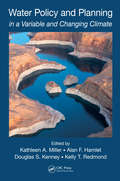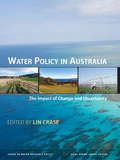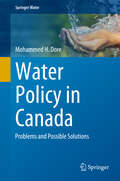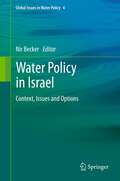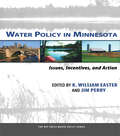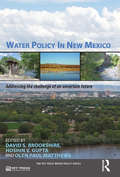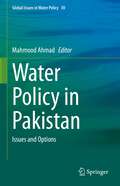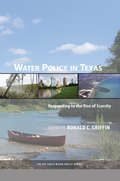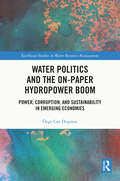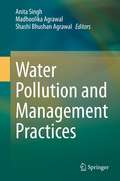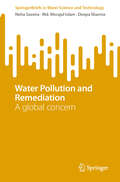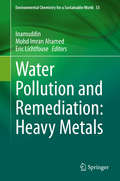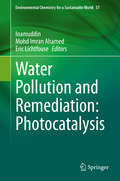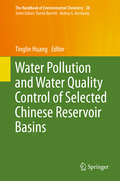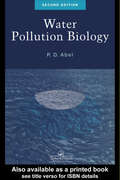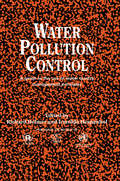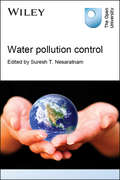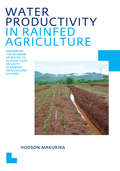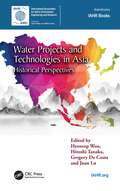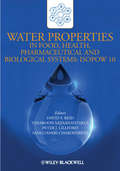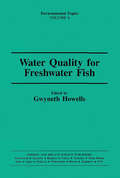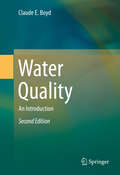- Table View
- List View
Water Policy and Planning in a Variable and Changing Climate (Drought and Water Crises)
by Kathleen A. Miller Alan F. Hamlet Douglas S. Kenney Kelly T. RedmondWater Policy and Planning in a Variable and Changing Climate addresses the current challenges facing western water planners and policy makers in the United States and considers strategies for managing water resources and related risks in the future. Written by highly-regarded experts in the industry, the book offers a wealth of experience, and explains the physical, socioeconomic, and institutional context for western water resource management. The authors discuss the complexities of water policy, describe the framework for water policy and planning, and identify many of the issues surrounding the subject. A provocative examination of policy issues surrounding western water resources, this book: Considers the implications of natural climate variability and anthropogenic climate change for the region’s water resources, and explains limitations on the predictability of local-scale changes Stresses linkages between climate patterns and weather events, and related hydrologic impacts Describes the environmental consequences of historical water system development and the challenges that climate change poses for protection of aquatic ecosystems Examines coordination of drought management by local, state and national government agencies Includes insights on planning for climate change adaptation from case studies across the western United States Discusses the challenges and opportunities in water/energy/land system management, and its prospects for developing climate change response strategies Presents evidence of changes in water scarcity and flooding potential in the region and identifies a set of adaptation strategies to support the long-term sustainability of irrigated agriculture and urban communities Draws upon Colorado’s experience in defining rights for surface and tributary groundwater use to explain potential conflicts and challenges in establishing fair and effective coordination of water rights for these resources Assesses the role of policy in driving flood losses Explores policy approaches for achieving equitable and environmentally responsible planning outcomes despite multiple sources of uncertainty Water Policy and Planning in a Variable and Changing Climate describes patterns of water availability, existing policy problems and the potential impacts of climate change in the western United States, and functions as a practical reference for the student or professional invested in water policy and management.
Water Policy in Australia: The Impact of Change and Uncertainty (Issues in Water Resource Policy)
by Lin CraseIn the last twenty years, policy makers in Australia have been forced to acknowledge that it is not possible to perpetually supply more water at a low cost. Consequently, the country has begun to focus on water resource management through legislative and institutional change attempting to allocate water in a more economically efficient and socially and environmentally acceptable manner. This book provides insight into the challenges of institutional change, as well as valuable lessons on the design of property rights for complex resources. Contributors from across disciplines address pertinent issues, such as irrigation in the Murray-Darling basin, one of Australia's largest drainage divisions; the progression from common law riparian rights to share-based entitlements that encourage sustainable water use; and the potential outcomes of the recent National Water Initiative, a wide-ranging strategy to improve water management and simultaneously maintain healthy groundwater and river systems.
Water Policy in Canada
by Mohammed H. DoreThis book deals with the water policy and management in Canada. It discusses various problems and risks in the fresh and drinking water supply in the second largest country in the world. Mohammed Dore argues that water is underpriced and used wastefully in Canada. In selected case studies, he illustrates the major threats from human activity to Canadian freshwaters and drinking water resources, including manufacturing, mining, oil sands production, animal farming and agricultural use. Selected case studies include reviews of even dramatic incidences, e. g. the Walkerton tragedy of 2000, when 7 people were killed and 200 went onto permanent dialysis treatment because of water contamination with harmful pathogens. The book warns that wastewater treatment standards are often not sufficient, so that many drinking water resources are in peril of wastewater contamination. As most of the water resources are provincial responsibility, the book discusses the water management policies in the different provinces separately. Through a detailed discussion and statistical analyses, it can define water policy and management lessons that emerge from the investigated case studies. It ends by contrasting water policy and practice in Canada with the practice in some European countries.
Water Policy in Israel
by Nir BeckerThis book deals with water policy in Israel. It offers a detailed examination of the main sources of Israel's water, its principle consumers, the gap between supply and demand, and the complex, contentious work of analyzing and devising the nation's water management and use policies. Water Policy in Israel is arranged in five broad sections: The dynamics of moving from one policy era to another; Supply management; Demand management; The importance of the Sea of Galilee and the Dead Sea; and Regional and global issues including water conflict and cooperation and climate change.
Water Policy in Minnesota: Issues, Incentives, and Action (RFF Press Water Policy Series)
by K. William Easter Jim PerryMinnesota has a unique role in U.S. water policy. Hydrologically, it is a state with more than 12,000 lakes, an inland sea, and the headwaters of three major river systems: the St Lawrence, the Red River of the North, and the Mississippi. Institutionally, Minnesota is also unique. All U.S. states use Total Maximum Daily Load (TMDL) approaches to addressing impaired waters. Every TMDL requires a substantial investment of resources, including data collection, modeling, stakeholder input and analysis, a watershed management plan, as well as process and impact monitoring. Minnesota is the only state in the union that has passed legislation (the 2007 Clean Water Legacy Act) providing significant resources to support the TMDL process. The book will be an excellent guide for policymakers and decision makers who are interested in learning about alternative approaches to water management. Non-governmental organizations interested in stimulating effective water quality policy will also find this a helpful resource. Finally, there are similarities between the lessons learned in Minnesota and the goals of water policy in several other states and nations, where there are competing uses of water for households, agriculture, recreation, and navigation.
Water Policy in New Mexico: Addressing the Challenge of an Uncertain Future (RFF Press Water Policy Series)
by Hoshin Gupta David Brookshire Olen Paul MatthewsThis book addresses water management issues in the State of New Mexico. It focuses on our current understanding of the natural world, capabilities in numerical modeling, existing and evolving regulatory frameworks, and specific issues such as water quality, endangered species and the evolution of new water management institutions. Similar to its neighboring states, New Mexico regularly experiences cycles of drought. It is also experiencing rapid economic growth while at the same time is experiencing a fundamental climate shift. These factors place severe demands on its scarce water resources. In addition to historical uses by the native inhabitants of the region and the agricultural sector, new competitive uses have emerged which will require reallocation. This effort is complicated by unadjudicated water rights, the need to balance the ever-increasing needs of growing urban and rural populations, and the requirements of the ecosystem and traditional users. It is clear that New Mexico, as with other semi-arid states and regions, must find efficient ways to reallocate water among various beneficial uses. This book discusses how a proper coordination of scientific understanding, modeling advancements, and new and emerging institutional structures can help in achieving improved strategies for water policy and management. To do so, it calls upon the expertise of academics from multiple disciplines, as well as officials from federal and state agencies, to describe in understandable terms the issues currently being faced and how they can be addressed via an iterative strategy of adaptive management.
Water Policy in Pakistan: Issues and Options (Global Issues in Water Policy #30)
by Mahmood AhmadThe water policy issues are well- documented in a large set of reports and studies, completed over time showing that the policy prescription and its implementation has been weak in the past as this book reveals. The key reforms initiated were lost due to a lack of government’s will and commitment and more so by pervasive political economy of water. Given this background, each chapter in the book follows a balanced approach in seeking and evaluating alternate solutions to water management issues, especially improvements in water governance and tackling new challenges emerging from the climate change in the short and long term. This approach underpins the importance of moving from the culture of piloting projects to actual implementation on an impact-oriented scale. The book would also highlight that most of the water solutions lie outside the water sector such as agriculture, population, economy, etc. Post COVID-19 policies are exploring new food-health nexus that calls for nature based solutions for our future agriculture growth. The book would show case pioneer work underway in Pakistan on how new policy discourse can reduce water use in agriculture without investing in expensive water technology and infrastructure, thus saving enough water for other competing purposes.
Water Policy in Spain
by Alberto Garrido M. Ramón LlamasThough the modern Spanish State was formed in the mid Fifteenth Century, historical records show that water works, statues, and the utilization of water dates back to centuries BC. As a semi-arid country, the effort to control, store and assure water supplies to cities and fields is present in numerous historical and political landmarks.Water polic
Water Policy in Texas: Responding to the Rise of Scarcity (Rff Press Water Policy Ser.)
by Ronald C. GriffinAs a water-scarce state with deep cultural attachments to private property rights, Texas has taken a unique evolutionary path with regard to water management. This new resource surveys past and current challenges for managing both groundwater and surface water, telling a comprehensive story about water policy in Texas, and identifying opportunities for improving future governance. Texas is the U.S. state that has experimented most thoroughly with water markets. In Water Policy in Texas, experts from broad disciplinary perspectives describe and analyze Texas water laws and management agencies, and the practices of water marketing and rate making in Texas. They explore the unique cases of the Edwards and Ogallala aquifers, the science and policy of environmental water stewardship, the extensive history of formalized water sharing with neighboring states and Mexico, and the opportunities for harnessing new technologies that might aid in addressing scarcity. This multidimensional, interdisciplinary book will be a valuable resource for students and researchers of Texas water policy, as well as for water managers worldwide, particularly those working within contexts of water scarcity.
Water Policy, Tourism, and Recreation: Lessons from Australia (RFF Press Water Policy Series)
by Lin Crase Sue O’KeefeThis book explores the complicated interrelationships between freshwater resources and tourism and recreation. The focus is on Australia, but comparisons with the experience of other countries are also made throughout. Yet Australia has been at the forefront of conflicts over drought and water use, particularly for irrigated agriculture, as well as of the design of policies and institutions for water policy, so there are many lessons which can be applied to other parts of the world. The authors examine in detail the relationships between water economics and supply, and the needs for tourism and recreation. The book discusses water use and access and the conflict between urban and recreational demands. It considers the institutional arrangements around water and the significance of property rights, including water markets and water pricing. Theoretical and practical models for increasing collaboration and cooperation such as the use of trusts are also developed and water trusts in the USA are examined. Specific chapters highlight the role of interest groups, such as the boating industry, to influence policy thinking and the practical trade-offs between access to urban water supplies and the requirements of recreation. Tourist behavior in relation to water use and pricing is also assessed.
Water Politics and the On-Paper Hydropower Boom: Power, Corruption, and Sustainability in Emerging Economies (Earthscan Studies in Water Resource Management)
by Özge Can DogmusThis book examines how the on-paper hydropower boom impacts the safe and fair access to water and energy in emerging economies.The global hydropower boom is largely made up of small hydropower plants located in emerging economies, but a lack of funding, over-ambitious planning, and corruption have halted the production of these projects. Describing this state as the ‘on-paper’ hydropower boom, this book shifts attention to the hydrosocial problems arising from hydropower projects that remain on paper. It examines how these proposed but unbuilt projects can lead to disruptions in the control and governance of water resources and increase the international dependence of emerging countries due to deep problems in their sustainable development planning and how all this can affect both ecosystems and the communities that depend on them. In doing so, it critically examines the dominant discourses on energy security and sustainable development, emphasises the extent to which the effects of global imperialism are at play, and examines the effects of international power relations in the hydrosocial context and their implications for perpetuating international relations of dependency. Further, this book provides a unique perspective on the global hydropower boom by highlighting that although the global hydropower boom largely remains on paper, it can still have a significant impact on human–water systems. Contributing to the debate on hydrosocial relationships, each chapter offers an insightful examination of the social, cultural, and political interactions that humans have with water and uses these insights to provide a nuanced understanding of the challenges and issues associated with on-paper plans.This book will be of great interest to students and scholars of water politics, water governance, political ecology, corruption and environmental economics, as well as sustainable development policymakers.
Water Pollution and Management Practices
by Anita Singh Madhoolika Agrawal Shashi Bhushan AgrawalWater pollution is a matter of concern for both developing and developed parts of the world. This book presents an overview on water pollution and its sustainable management. The book discusses the fundamental aspects of water pollution as well as advanced sustainable technologies for abating water pollution. It is a comprehensive collection of information related with water pollutants which are extremely harmful to man, other living organisms and to the ecosystems. It is all-inclusive coverage of technical, socio-political, scientific as well as social issues revolving around water pollution and management. The book brings out innovative ideas promoting sustainable technologies and extensively covers the diversity of modern technologies related to prevention of water pollution. Book also covers social aspects of water related issues. It is an essential reading for upper level graduates and undergraduates pursuing environmental studies and researchers in the field of waste water management
Water Pollution and Remediation: A global concern (SpringerBriefs in Water Science and Technology)
by Neha Saxena Md. Merajul Islam Deepa SharmaToday, there is much discussion about the dangers of water contamination to human health. Numerous environmental studies and projects are undertaken and accomplished every year. Despite this, most developing countries continue to struggle with the inefficient administration of their water supplies. The problem of contaminated water and the method of purifying it are both extremely challenging, and much of the research done on the topic is probably not up to the mark to cope with the current environmental issues. Henceforth, appropriate methods need to be developed and established to improve water quality. Through this book, the authors aim to provide a framework for understanding the causes, pollutants, and potential remediation for water contamination. The text provides up-to-date reviews of the latest research and practises for removing contaminants from water through green methods.
Water Pollution and Remediation: Heavy Metals (Environmental Chemistry for a Sustainable World #53)
by Inamuddin Mohd Imran Ahamed Eric LichtfousePollution of waters by toxic metals is accelerating worldwide due to industrial and population growth, notably in countries having poor environmental laws, resulting in many diseases such as cancer. Classical remediation techniques are limited. This books reviews new, advanced or improved techniques for metal removal, such as hybrid treatments, nanotechnologies and unconventional adsorbents, e.g. metal-organic frameworks. Contaminants include rare earth elements, arsenic, lead, cadmium, chromium, copper and effluents from the electronic, textile, agricultural and pharmaceutical industries.
Water Pollution and Remediation: Photocatalysis (Environmental Chemistry for a Sustainable World #57)
by Inamuddin Mohd Imran Ahamed Eric LichtfouseIn the context of climate change and fossil fuel pollution, solar energy appears as a cheap and sustainable fuel for many environmental applications, yet the efficiency of techniques has to be improved. This book reviews recent methods and applications of photocatalysis for the treatment of wastewater containing bacteria, heavy metals, organic pollutants, dyes and tannery effluents. Basics of water pollution, polluted river ecosystems and membranes are also detailed.
Water Pollution and Water Quality Control of Selected Chinese Reservoir Basins
by Tinglin HuangThis volume provides a detailed overview of water pollution and control of several selected Chinese reservoirs. It explores sediment contamination as well as algal blooms and their impact on water quality. Several chapters also discuss various methods of quality control, such as mixing-oxygenation combined with microbial remediation technologies. Due to their broad geographical distribution and different nutrition levels, the investigated reservoirs, the Jinpen, Shibianyu, Fenhe, Zhelin and Zhoucun reservoirs, can be regarded as representative for China. This comprehensive work will appeal to researchers, advanced students and reservoir managers.
Water Pollution Biology
by P.D. AbelPresents an examination of the scale of water pollution problems, and, through case studies, explores the type of investigations biologists need to undertake in solving them. The text draws comparisons between British and European practice,
Water Pollution Control: A Guide to the Use of Water Quality Management Principles
by Richard Helmer Ivanildo HespanholThis is a handbook for policy makers and environmental managers in water authorities and engineering companies engaged in water quality programmes, especially in developing countries. It is also suitable for use as a textbook or as training material.
Water Pollution Control
by Suresh T. NesaratnamDesigned to accompany the new Open University course in Environmental Monitoring and Protection, this is one of four new titles which will equip the reader with the tools to undertake Environmental Impact Assessments (EIAs). Used in planning, decision-making and management, EIAs review both the theoretical principles and environmental considerations of engineering and environmental projects to help steer fundamental legislation in the right direction.This book begins with a discussion of the basics of the hydrological cycle and a description of the natural aquatic environment including the normal composition of surface waters. Further chapters detail the sources of water pollution and the affects of water pollution including biological treatment of sewerage, sludge treatment and disposal, before addressing industrial wastewater treatment and water quality assessment.
Water Productivity in Rainfed Agriculture: Redrawing the Rainbow of Water to Achieve Food Security in Rainfed Smallholder Systems (IHE Delft PhD Thesis Series)
by Hodson MakuriraThe challenge of water scarcity as a result of insufficient seasonal rainfall and dry spell occurrences during cropping seasons is compounded by inefficient agricultural practices by smallholder farmers where insignificant soil and water conservation efforts are applied. The hypothesis of this research is that many of the past research efforts have
Water Projects and Technologies in Asia: Historical Perspectives (IAHR Books)
by Hyoseop Woo Hitoshi Tanaka Gregory De Costa Juan LuThis book is a collection of highly refined articles on historical water projects and traditional water technologies of international interest in the Asian region, addressing information on past water projects (mostly before the 20th century) in the Asian regions that are technically and culturally of interest and educationally valuable. This book explores historical water projects in these regions, presenting technologies used at the time, including calculation and forecasting methods, measurement, material, labor, methodologies, and even water culture. It is expected that the old Asian wisdom of "reviewing the old and learning the new" would be realized to a certain extent in modern planning and practice of water projects. This book will enable the reader to understand historical water projects and technologies in the Asian region. It can be used as a one-stop resource to source notable Asian water projects and their relevance to modern-day technology. In this regard, this book is expected to be of interest to a variety of audiences, including the corresponding Asian regions and other international audiences interested in Asian water history from an engineering perspective.
Water Properties in Food, Health, Pharmaceutical and Biological Systems: ISOPOW 10
by David S. Reid Tanaboon Sajjaanantakul Peter J. Lillford Sanguansri CharoenreinThis title focuses on the comprehension of the properties of water in foods, enriched by the approaches from polymer and materials sciences, and by the advances of analytical techniques. The International Symposium on the Properties of Water (ISOPOW) promotes the exchange of knowledge between scientists involved in the study of food materials and scientists interested in water from a more basic point of view and the dialogue between academic and industrial scientists/technologists. This comprehensive book covers the topics presented at the 10th ISOPOW held in Bangkok, Thailand in 2007, including water dynamics in various systems, the role of water in functional food and nano-structured biomaterials. Special features include: Latest findings in the properties of water in food, pharmaceutical and biological systems Coverage of the 10th International Symposium on the Properties of Water (ISOPOW) Includes water dynamics, water in foods stability, and water in micro and nano-structured food and biomaterials Reflects the vast array of research and applications of water world wide
Water Properties of Food, Pharmaceutical, and Biological Materials (Food Preservation Technology)
by Maria del Pilar Buera Jorge Welti-Chanes Peter J. Lillford Horacio R. CortiUnique and informative, Water Properties of Food, Pharmaceutical, and Biological Materials is based on lectures and papers given by leading international researchers at the 9th International Symposium of the Properties of Water in Foods (ISOPOW 9) that took place in September 2004. Each chapter presents an authoritative account of
Water Qual Freshwater Fish
by Gwyneth HowellsThis book covers the major polluting chemicals affecting fisheries in European fresh waters and the effort required to extend the work towards the preparation of critical reviews on less important chemicals would be out of proportion to the benefits obtained.
Water Quality
by Claude E. BoydThe revised second edition updates and expands the discussion, and incorporates additional figures and illustrative problems. Improvements include a new chapter on basic chemistry, a more comprehensive chapter on hydrology, and an updated chapter on regulations and standards. This book presents the basic aspects of water quality, emphasizing physical, chemical, and biological factors. The study of water quality draws information from a variety of disciplines including chemistry, biology, mathematics, physics, engineering, and resource management. University training in water quality is often limited to specialized courses in engineering, ecology, and fisheries curricula. This book also offers a basic understanding of water quality to professionals who are not formally trained in the subject. Because it employs only first-year college-level chemistry and very basic physics, the book is well-suited as the foundation for a general introductory course in water quality. It is equally useful as a guide for self-study and an in-depth resource for general readers.
